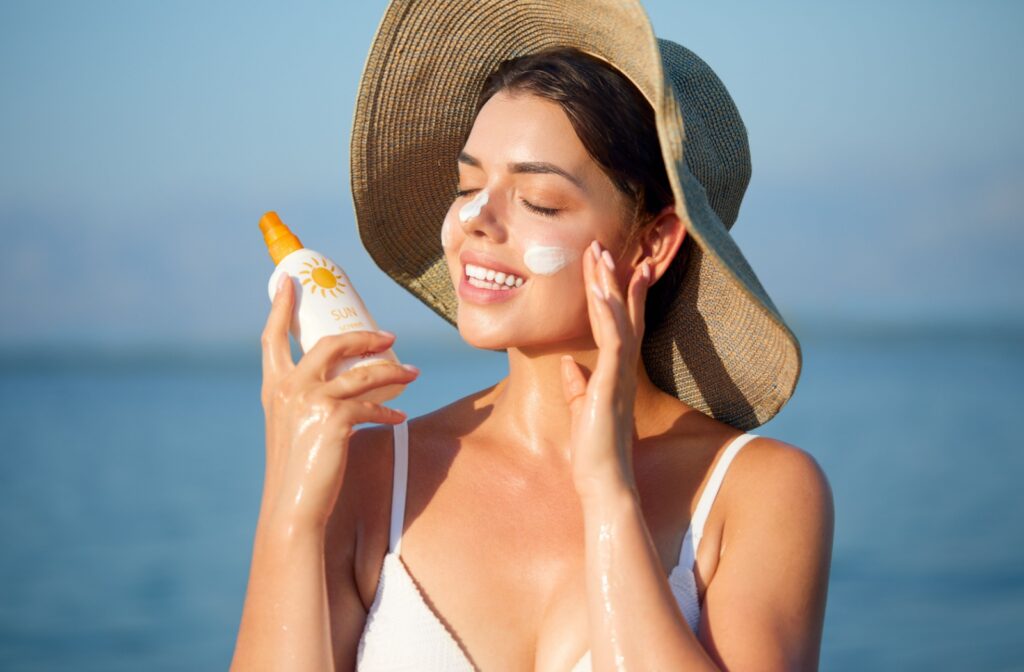When sunscreen accidentally enters the eye, it often causes immediate discomfort: watering, stinging, redness, or blurry vision. This reaction occurs because many sunscreens contain ingredients like zinc oxide, titanium dioxide, or chemical UV filters that can irritate delicate eye tissues.
If you get sunscreen in your eyes, rinse them immediately with clean water, use lubricating eye drops if available, and contact an eye doctor if irritation or blurred vision persists. It’s important to know that while this situation is usually temporary, prompt and proper action can make a difference in comfort and recovery.
Immediate Steps to Soothe the Irritation
Rinse Promptly with Clean Water
Begin by gently flushing both eyes with clean, lukewarm water. Doing so helps remove sunscreen particles that may be causing irritation. Let a gentle stream pour over the eyelids, while keeping them open, for at least a minute. This helps dilute and wash away the irritant, reducing stinging and redness.
- Use a clean cup, gentle shower flow, or faucet to rinse the eyes
- Avoid harsh sprays or jets of water that could worsen the irritation
- Pat the skin around the eyes dry with a clean, soft towel after rinsing
Use Saline or Sterile Eye Drops if Available
If you have saline solution or lubricating eye drops on hand, apply a few drops after rinsing your eyes. These can provide added relief by soothing and lubricating the eye’s surface. They also help flush out any remaining sunscreen particles.
Rest Your Eyes in a Calm Environment
Once rinsed, sit in a calm, low-light area. Reducing screen exposure or bright lights gives your eyes a chance to settle. Keeping the eyelids closed briefly can also help reduce stinging. Gentle blinking can promote tear flow, which helps naturally remove residual irritants.
Preventive Measures to Avoid Sunscreen in the Eyes
Choose Eye-Safe Sunscreens & Glasses
Selecting products and applying them thoughtfully can prevent future incidents. Look for sunscreens labeled as eye-safe or designed specifically for use around the eyes. Mineral-based formulas with zinc oxide or titanium dioxide tend to be gentler and less prone to migrating into the eye.
Wearing sunglasses when applying sunscreen to your face can act as a physical barrier that keeps the lotion away from your eyes. Choosing wraparound styles offers better protection from accidental contact.
Apply Carefully Using the Right Technique
How sunscreen is applied makes a difference. Applying a small amount to fingertips and gently patting it around the orbital bone helps avoid getting the product too close to the lash line. Spraying sunscreen onto fabric (like a towel or arm) before applying reduces airborne particles that could drift toward the eyes.
Rinse Immediately After Contact
Sometimes a stray drop or smudge is inevitable. If you feel even a little irritation, rinse your eyes right away rather than waiting until symptoms become more intense. Quick action can limit stinging and redness before they escalate.
Recognizing When to Seek Professional Help
Persistent Discomfort or Vision Changes
If stinging, redness, blurred vision, or excessive tearing continues beyond several hours, contact an eye care professional. Sunscreen chemicals can sometimes lead to more significant irritation or even a minor chemical burn in rare cases. It’s important to have an optometrist evaluate any ongoing pain, light sensitivity, or vision disturbances.
Signs of Infection or Corneal Involvement
If the eye becomes extremely red, shows discharge, or if you develop significant pain or sensitivity to light, seek medical attention promptly. These could be indicators of infection or corneal abrasion, which require professional treatment. Contacting your eye doctor or visiting an urgent eye care clinic can help assess and treat these issues appropriately.

Protecting Your Eyes in Outdoor Settings
Practice Safe Sunscreen Habits Year-Round
Sunscreen isn’t just for beach days. It’s essential daily protection, even during cooler months. When using these products during outdoor or water activities, take extra care around the face and temple regions. Always avoid the immediate eye area and use additional protective gear like hats, visors, or sunglasses.
Keep Eye Drops Handy During Activities
Carrying sterile eyewash or lubricating drops when heading outdoors can provide a quick remedy if sunscreen contact occurs. These drops are small and convenient to store in a bag or backpack and can serve as a useful buffer until proper rinsing is possible.
Rinse Thoroughly After Swimming
Chlorine, saltwater, and sunscreen residues can combine to intensify irritation. After swimming, rinse your face and eyes thoroughly with clean water to remove sunscreen before it spreads. Repeat any time you feel a slight stinging to prevent escalation.
Your Eye Health Matters
Your eyes can be exposed daily to the sun, wind, chlorine, salt, and more. Caring for them includes both preventive measures and knowing what to do in moments of irritation. Understanding how to handle sunscreen exposure promptly and safely helps you protect your eyes now and in the years to come.
If you are experiencing lasting symptoms from getting sunscreen in your eyes, book an appointment at the Camarillo Vision Center for urgent eye care.



